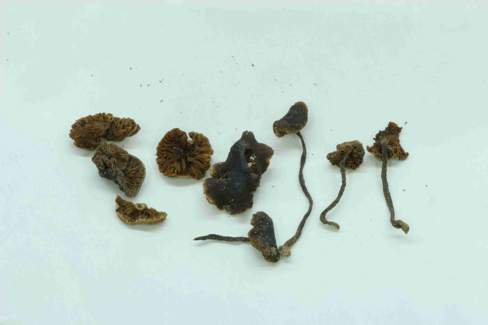 Hebeloma indicum (Photo: With thanks to Universität Innsbruck)
Hebeloma indicum (Photo: With thanks to Universität Innsbruck)Taxonomy
Full name: Hebeloma indicum (K.A Thomas, Peintner, M.M. Moser & Manim.) B.J. Rees & Orlovich, Mycologia 105 (4): 1055 (2013)Genus: Hebeloma
Section: Porphyrospora
Basionym:
Anamika indica K.A. Thomas, Peintner, M.M. Moser & Manim., Mycol. Res. 106 (2): 247 (2002)
Types: INDIA: Kerala, Wayanad district, Ponkhuzhy (approx. 11.6875°N, 76.3919°E, alt. approx. 850 m a.s.l.) in tropical woodland under Hopea sp., 23 Jul. 1997, K.A. Thomas (T108b) (Holotype. herbarium acc. no. IB 19971307, HJB1000384).
- arrow_drop_downarrow_drop_upEtymology
- arrow_drop_downarrow_drop_upOriginal diagnosisPileo 9-30 mm diam., primo hemisphaerico, conico-convexo, convexo, dein plano-convexo, pallide aurantiaco, griseoaurantiaco, pallide brunneolo, brunneo vel margine pallescente; lamellis adnatis, subconfertis usque confertis, primo albidulis, dein pallide aurantiacis, brunneis, sub lente acie fimbriato; stipite 15-55 x 2-6.5 mm, tereti, plus minusque aequali, apice albidulo, pallide aurantiaco, basi versus pallide brunneo; cortina tenue, interdum zonam subannulatam formante; carne pallide brunnea, odore inconspicuo; sporis in cumulo brunneis. Sporis 9.5-11.2 (-14) x 6.5-7.7 (-8.5) μm, amygdaliformibus usque sublimoniformibus, verrucosis, perisporio bene evoluto, absque poro germinativo, sed callo conspicuo, ornamentatione epitunicae cavernoso; basidiis 25-35 x 7.5-10.5 μm, tetrasporigeris ; cheilo-, pleuro-caulocystidiisque praesentibus, versiformibus, clavatis, uteriformibus usque fusoideis, saepe capitatis vel rostratis, pileipelli efformant e epicute e hyphis tenuibus repentibus, cylindraceis et hypocute e hyphis crassis, subcellularibus, incrustatis. Fibulis praesentibus. Habitatio: terrestris in silvis, prope Hopea (Dipterocarpaceae).
- arrow_drop_downarrow_drop_upEnglish translationPileus 9-30 mm in diameter, at first hemispherical, conical-convex, convex, then plano-convex, pale orange, grey-orange, pale brownish, brown or becoming pale on the margin; lamellae adnate, almost crowded to crowded, at first whitish, then pale orange, brown, edge fimbriate under a lens; stipe 15-55 x 2-6.5 mm, terete, more or less equal, whitish, pale orange, pale brown towards the base; cortina thin, at times forming a subannulate zone; context pale brown, smell hardly noteworthy; spores brown in mass. Spores 9.5-11.2 (-14) x 6.5-7.7 (-8.5) μm, amygadiform to subcitriform, roughened, perispore well-developed, without a germ pore, but callus remarkable, ornamentation of the epitunica cavernous; basidia 25-35 x 7.5-10.5 μm, four-spored; cheilo-, pleuro- and caulocystidia present, versiform, clavate, utriform to fusoid, often capitate or rostrate, pileipellis constituted by an epicutis of thin repent cylindraceous hyphae and a subcutis of thick, subcellular encrusted hyphae. Clamps present. Habitat: terricolous in woods near Hopea (Dipterocarpaceae).
References
Description
- arrow_drop_downarrow_drop_upThresholds
Description of Hebeloma indicum based on 2 collections
- arrow_drop_downarrow_drop_upMacroscopic descriptionPileus: (9) 19 (30) mm diameter; shape convex or umbilicate; characters Not recorded; margin characters involute or smooth; viscosity tacky when moist; colour variation two color; colour at centre occasionally pinkish buff, dark pinkish buff, cinnamon, yellowish brown, brick or orange-brown.
Lamellae: attachment adnate; maximum depth up to 5 mm; number of complete lamellae up to 60; presence of tears Not recorded; white fimbriate edge Not recorded.
Cortina presence: variable.
Stipe: (15) 35 (55) x (2) 4 (6) {median} x (3) 5 (7) {basal} mm; stipe Q 7.5–8.5; base shape clavate or cylindrical; floccosity fibrillose or weakly floccose; rooting Not recorded; thick rhizoids at base Not recorded;
Context: Texture firm; stipe interior hollow or stuffed, often superior wick; stipe flesh discolouring Not recorded; slenderness measure up to 14.0; smell odourless; taste Not recorded.
Spore deposit colour: often fawn or dark brick.
Exsiccata characters: Not recorded.
- arrow_drop_downarrow_drop_upMicroscopic descriptionSpores: shape amygdaloid or limoniform; colour in microscope often brown or yellow; guttules yes. papilla often yes or very strongly; Spore Code: O3 O4; P2 P3; D3 D4.
Basidia: 24–31 x 7–9 μm; ave. Q up to 3.3; spore arrangement Not recorded;
Cheilocystidia: main shape balloon-shaped, pyriform, turbinate, utriform or ventricose; special features observed often irregular, large, many collapsed in exsiccata, rostrate or uniform; cheilocystidia ratios: A/M = up to 1.03; A/B = up to 0.88; B/M = up to 1.44.
Pleurocystidia: seen.
Ixocutis: epicutis thickness (measured from exsiccata) not recorded; ixocutis hyphae width up to 10 μm; ixocutis hyphae encrustation yes; shape of trama elements beneath subcutis Not recorded.
Caulocystidia: Similar to cheilocystidia but larger.
- arrow_drop_downarrow_drop_upSpore measurements
- arrow_drop_downarrow_drop_upCheilocystidia measurements
- arrow_drop_downarrow_drop_upHabitat and distributionAcross our collections, Hebeloma indicum has only been recorded as associating with Hopea (family Dipterocarpaceae). The growth habit of our collections was gregarious or scattered.
According to our current collections, the species is found only in Asia-Tropical. On the continent, collections have been found only in the South Western Ghats moist deciduous forests WWF ecoregion The World Wildlife Fund (WWF) have divided the world into 867 terrestrial ecoregions. The ecoregion here is estimated by mapping from the GPS coordinates of the collection using data made available by Dinerstein et al (2017). Use this webtool to explore the ecoregions visually or see a full list of current ecoregions on Wikipedia. (tropical & subtropical moist broadleaf forests biome). From collector information, it appears collections have been found in the 1.9 Forest – Subtropical/tropical moist montane (50.0%) and 1.5 Forest – Subtropical/tropical dry (50.0%) IUCN habitats We map from the collector's description of the habitat to the International Union for Conservation of Nature (IUCN)'s definition using a standardised set of rules. Please see this page for a full list of IUCN habitats.. Within Tropical Asia all our records are from Indian Subcontinent (India).
Geographic distribution
Phenology
- arrow_drop_downarrow_drop_upAdditional cited collections